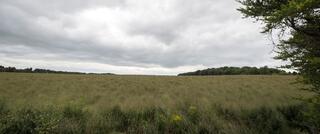Bioenergy crops reduce carbon emissions – if grown on the right land

Fuel from switchgrass grown on carbon-rich soil is worse than gasoline.
The Science
Switchgrass is a plant that grows quickly in poor soils without a lot of fertilizer and can be converted into fuels to replace gasoline, diesel, and other petroleum products. Scientists found that abandoned farm fields and other marginal lands in Michigan could grow enough switchgrass to reduce emissions by at least 1.2 million metric tons per year, the equivalent of taking nearly 260,000 passenger cars off the road. But fuel made from switchgrass grown on the wrong type of soils creates more greenhouse gasses than gasoline.
The Impact
Non-food plants like switchgrass are considered good sources of biofuels. Because they absorb carbon dioxide from the air, burning these biofuels does not add heat-trapping gas to the atmosphere. This paper shows that switchgrass can slow climate change by pulling carbon dioxide from the atmosphere and storing it in soil, so long as that soil is not already full of carbon. This finding could guide policy decisions about where energy crops should be planted to achieve the best results.
Summary
Researchers with the Great Lakes Bioenergy Research Center used computer models to simulate the yields of switchgrass planted on unutilized, or marginal, agricultural lands in Michigan under varying conditions. The study assumed three plantings over 30 years and evaluated yields with and without nitrogen fertilizers. The researchers found that Michigan’s marginal lands could grow enough fertilized switchgrass to produce more than 150 million gallons of biofuel per year. Almost all of that fuel would meet the federal Renewable Fuel Standard guidelines of 60% lower lifecycle emissions than gasoline. About 75% of that fuel would be carbon negative because switchgrass increases the amount of soil carbon in marginal land with low fertility. However, switchgrass planting depletes carbon-rich soils like wetlands, which account for about 11% of Michigan’s marginal lands, resulting in greater emissions than gasoline. These findings highlight the importance of using site assessments, soil data, and modeling to determine whether land is suitable for energy crop production.
Contact
Bruce E. Dale
University Distinguished Professor of Chemical Engineering and Materials Science, Michigan State University
bdale@egr.msu.edu
Seungdo Kim
Associate research professor of Chemical Engineering, Michigan State University
kimseun@egr.msu.edu